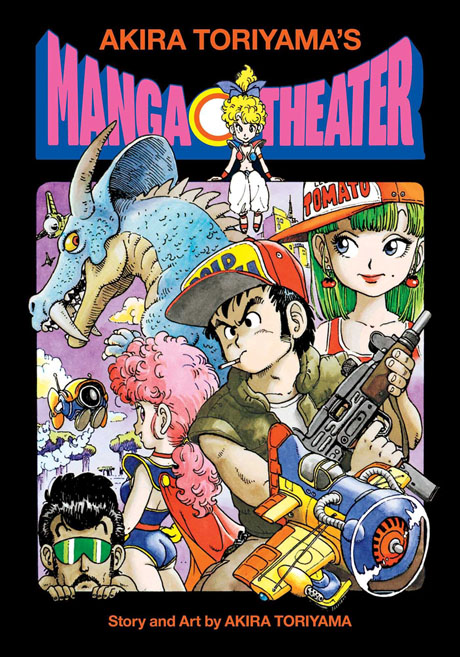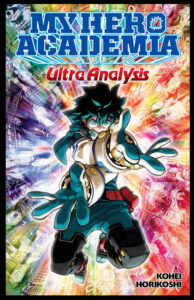
It’s beginning to look a lot like Christmas, and Viz has two new books that will make excellent gifts for the anime and manga fans in the family.
Since Kohei Horikoshi’s manga My Hero Academia debuted in 2014, it’s sold more than 50 million books worldwide, and the anime series is one of the break-out hits of the last decade. For the uninitiated, Academia takes place in an alternate world where most children are born with “Quirks” super powers that enable them to become superheroes–or arch-villains. Izuku “Deku” Midoriya was born without a Quirk, but his willingness to help anyone in trouble, regardless of personal risks, leads All-Might, the Number 1 superhero, to share his redoubtable “One For All” Quirk with him.

Short, skinny and untidy, Deku looks more like a comic book fan than a comic book hero. He faces a precipitously steep learning curve at U.A. High, which trains elite superheroes: His classmates have been developing their Quirks since infancy. Justin Briner, who provides the character’s English voice, comments, “A lot of hero characters are handed everything; Deku really has to work for it. He’s dealing with pretty substantial high school-age problems, struggling with his self-worth, with people telling he should find a regular lot in life. Most high school kids know what that feels like, so it makes him easier to root for.”
My Hero Academia is a series that bridges the shonen/shojo (boys’/girls’) manga and anime gap. The girls have powerful Quirks and fulfill superheroic challenges as capably as the boys in their class. Two of Deku’s closest friends and allies are Ochaco Urakawa, who can negate the effect of gravity on objects she touches, and the sensible Tsuyu Asui, who commands frog-like powers.
In an era of cyber sniping, disinformation campaigns and unbridled greed, Deku’s unswerving devotion to helping others, not because he seeks rewards or fame, but because it’s the right thing to do feels worth emulating.My Hero Academia: Ultra Analysis offers a character by character guide to the large cast. The notes include not only each character’s key relationships, powers and moves, but their height, birthday and blood type. (In Japan, blood types have a significance similar to astrological signs in America). The book includes a dialogue with Tite Kubo, the creator of Bleach, which Horikoshi cites as a major influence. “Ultra Analysis” would make a perfect stocking-stuffer for any tween or teen fan.
Akira Toriyama ranks among the world’s most successful graphic artists: His Dragon Ball series has sold more than 400 million books worldwide; about 80% of the sales of “Harry Potter.” The mixture of martial arts training, slapstick humor and supernatural slugfests in the Dragon Ball manga and animated series delights adolescent boys, many of whom never lose their affection for Goku, Vegeta and Toriyama’s other muscular heroes: Gyms in Southern California are full of 20-something guys sweating in Dragon Ball T-shirts.
Akira Toriyama’s Manga Theater is an anthology of the artist’s early work, which has been difficult to find in English. It took Toriyama some time to hit his stride, but the physical action and broad comedy were always there. “Wonder Island” (1983) features a caricature of Clint Eastwood’s Dirty Harry, one Detective Herring, and a Tarzan figure who sports shades and a Village People moustache.
Fans who scrutinize these early comics for the roots of Dragon Ball, will find the curly-haired heroines in “Mad Matic” (1982) and “Pola & Roid” (1981) suggest preliminary versions of Bulma, the female genius who invents a time machine in Dragon Ball. Tangtong, the hero of “Dragon Boy” (1983), is clearly a rough draft of young Goku. Manga Theater will please any aspiring Super Saiyan in the family.

My Hero Academia: Ultra Analysis by Kohei Horikoshi
(Viz: $16.99, 288 pp., paperback)
Akira Toriyama’s Manga Theater by Akira Toriyama
(Viz: $34.99, 626 pp., hardcover)
- Charles Solomon’s Animation Year End Review 2023 - December 28, 2023
- INTERVIEW: Makoto Shinkai on “Suzume” - November 27, 2023
- Interesting Portrayals of Gay Men in Manga/Anime - June 12, 2023


 December 7th, 2021
December 7th, 2021  Charles Solomon
Charles Solomon 
 Posted in
Posted in  Tags:
Tags: 






